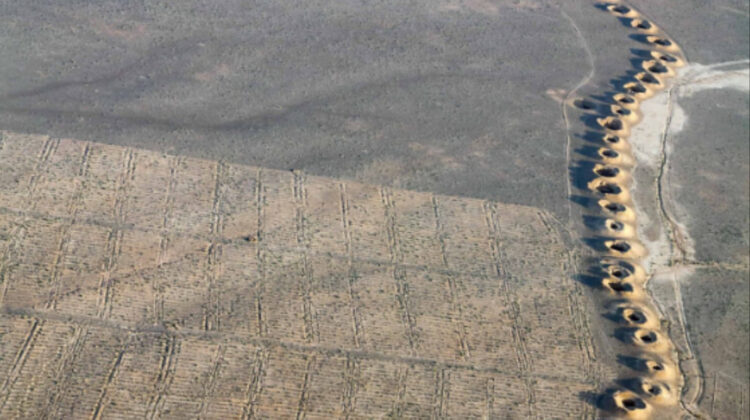
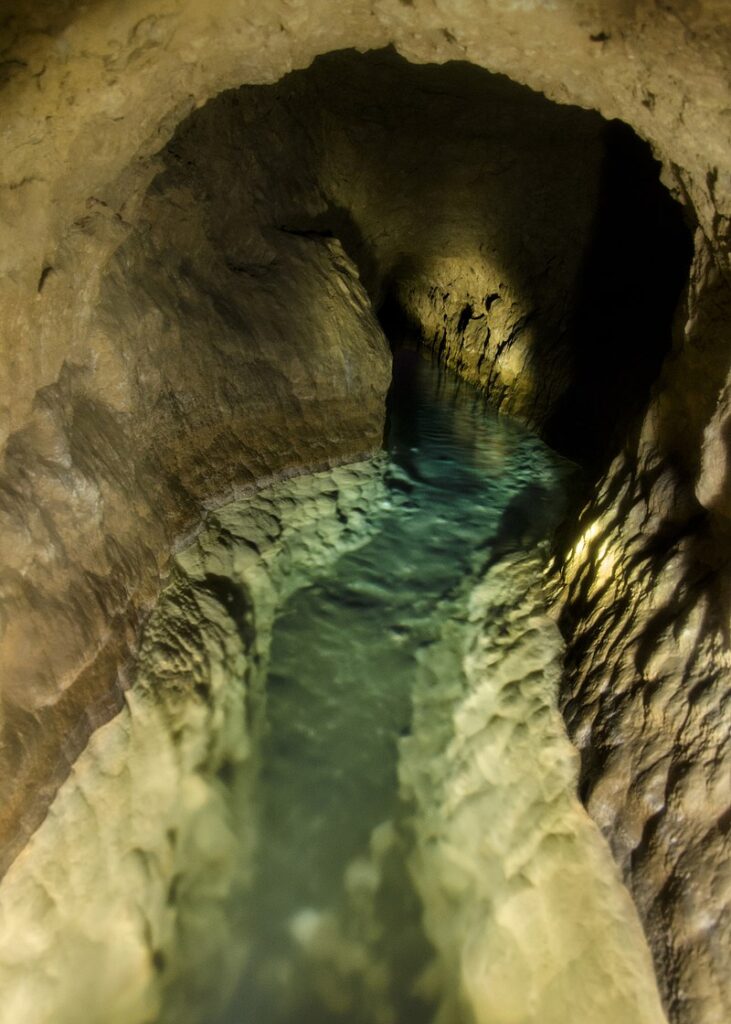
A qanat, also known as kārīz, is an underground aqueduct system used for transporting water from an aquifer or water well to the surface. Originating in Iran around 3,000 years ago, the system has various regional names across North Africa and the Middle East, including foggara in Algeria, khettara in Morocco, and falaj in Oman. The qanat system is still operational in Iran, Afghanistan, Oman, the Turfan region of China, Algeria, and Pakistan.
This water supply system is highly efficient in transporting water over long distances in hot, dry climates while minimizing water loss due to evaporation. The system is also resistant to natural disasters such as earthquakes and floods, as well as deliberate destruction during times of war. It delivers a consistent flow of water that is almost insensitive to levels of precipitation, making it highly reliable.
Karez, a variant of qanat, consists of a series of vertical shafts connected by a gently sloping tunnel that taps into underground water and delivers it to the surface through gravity. The vertical shafts are for maintenance purposes only, and water is typically used once it emerges from the daylight point.
The qanat system continues to provide a reliable source of water for human settlements and irrigation in hot, arid, and semi-arid climates. However, the quality, volume, and regularity of groundwater are crucial factors in the effectiveness of the system. Historically, much of the population in Iran and other arid countries in Asia and North Africa depended on water from qanats, with many populated areas coinciding with the regions where qanats are possible.
Names
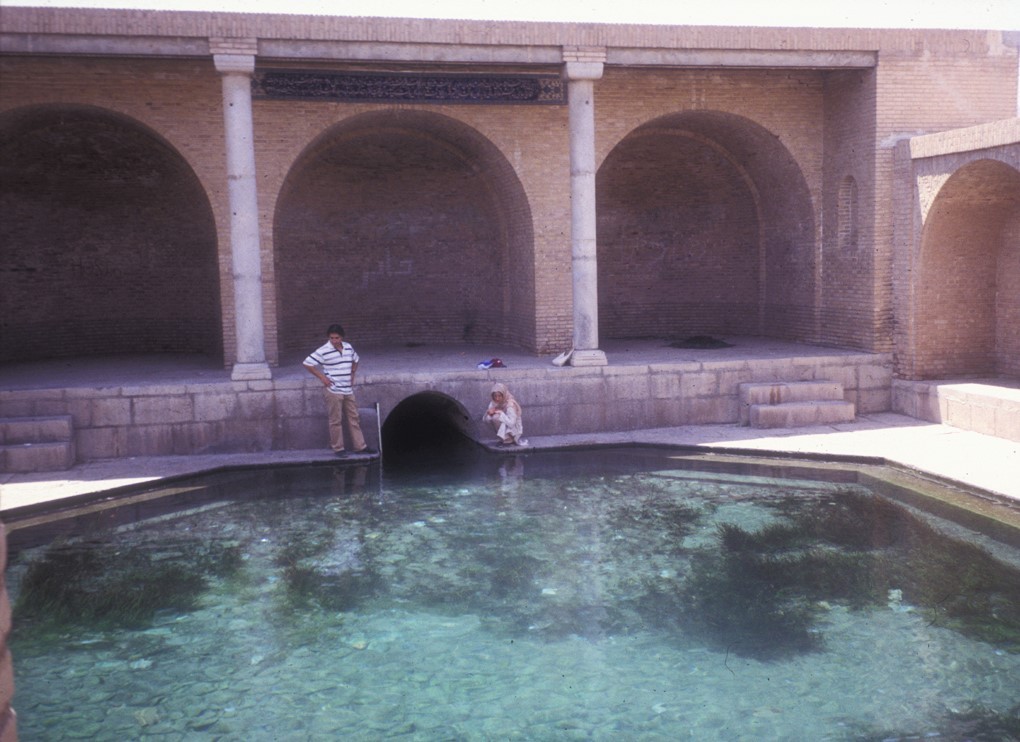
Common English variants of qanat include kanat, khanat, kunut, kona, konait, ghanat, and ghundat, among others.
The Arabic word qanāh (قناة) translates to “channel,” while in Persian, the word kārīz (or kārēz; كاريز) is used, derived from the earlier word kāhrēz (كاهریز). The Persian word qanāt (قنات) is also commonly used. In Azerbaijan, qanats are referred to as kahriz/kəhriz, while in Morocco, the term khettara is used. In Spain, qanats are known as Galerías, minas, or viajes de agua, while in the United Arab Emirates and Oman, they are referred to as falaj (Arabic: فلج). In North Africa, they are called foggara or fughara, and in Asia and North Africa, alternative terms for qanats include kakuriz, chin-avulz, and mayun.
Origins
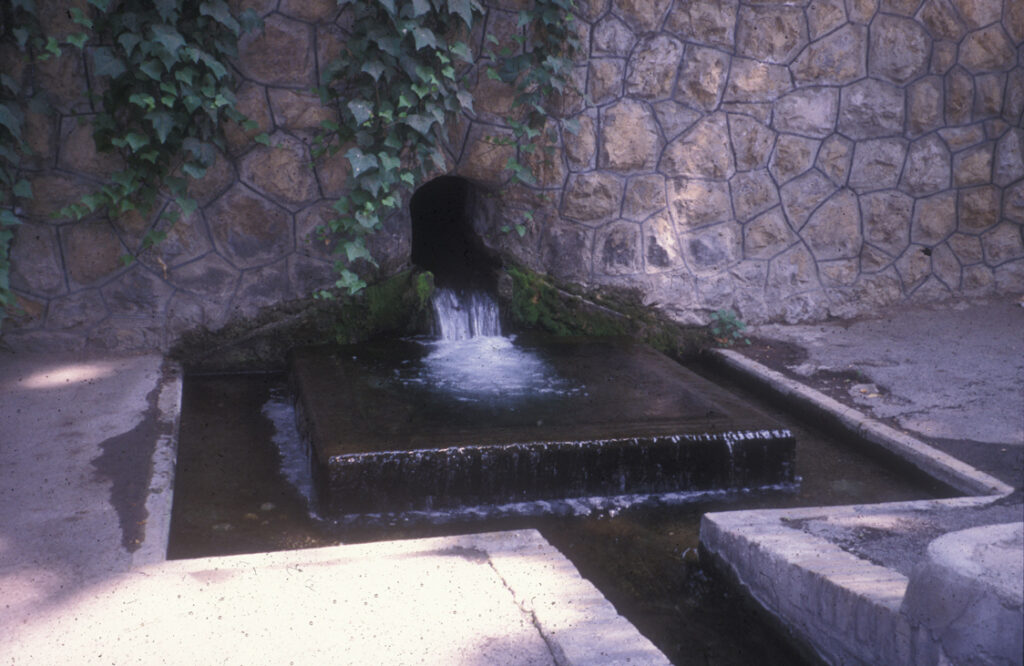
Qanat technology is widely believed to have been developed in ancient Iran by the Persian people during the early 1st millennium BCE, with evidence suggesting slow westward and eastward spread from there. However, some sources suggest a Southeast Arabian origin, and similar systems appeared to be independently developed in China and South America. Cotton, which is indigenous to South Asia, has been cultivated on the Indian subcontinent for a long time and was introduced to the Middle East through transregional trade networks. The theory is that the qanat was developed to irrigate cotton fields, first in modern-day Iran, where it doubled the amount of available water for irrigation and urban use, leading to larger surpluses of agriculture and increasing urbanization and social stratification. In Peru, a similar water supply technology called puquios was developed in the extremely arid coastal desert. Most archaeologists believe that the puquios are indigenous and date to about 500 CE, and they were still in use in the Nazca region in the 21st century.
Technical features
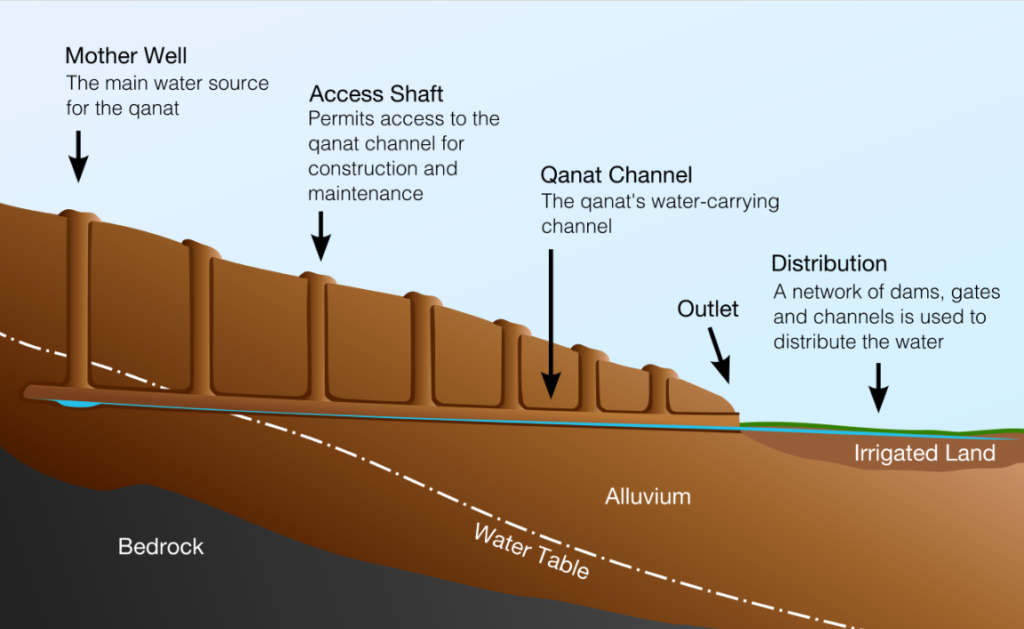
In arid and semi-arid regions, qanats are a common form of transportation route for groundwater to consumption areas along tunnels. The qanat system is not only economical but also sustainable for irrigation and agricultural purposes. The flow of groundwater depends on the grain size of sediments, so the tunnels in qanats are filled with coarser material than the surrounding hose geological formations. Qanats are primarily constructed along valleys where Quaternary sediments are deposited, allowing water to be transported over long distances in hot, dry climates without significant water loss to evaporation.
Constructed as a series of vertical shafts connected by a gently sloping tunnel, qanats efficiently deliver large amounts of subterranean water to the surface without the need for pumping. The water drains by gravity from an upland aquifer, with the destination lower than the source. Typically, qanats start below the foothills of mountains, where the water table is closest to the surface. From this source, the qanat tunnel slopes gently downward, slowly converging with the steeper slope of the land surface above, and the water finally flows out above ground where the two levels meet. To connect a populated or agricultural area with an aquifer, qanats must often extend for long distances.
Qanats are sometimes divided into smaller underground canals called kariz, which distribute the water. These smaller canals are below ground to avoid contamination and evaporation. Water from a qanat is often stored in a reservoir, with night flow stored for daytime use. An ab anbar is an example of a traditional Persian qanat-fed reservoir for drinking water. The qanat system is resistant to natural disasters such as earthquakes and floods and deliberate destruction in war. It is almost insensitive to the levels of precipitation, delivering a flow with only gradual variations from wet to dry years. Qanats are powered only by gravity, making their operation and maintenance costs low once built. They transfer freshwater from the mountain plateau to the lower-lying plains with saltier soil, helping to control soil salinity and prevent desertification.
It is essential not to confuse the qanat with the spring-flow tunnel typical to the mountainous area around Jerusalem. Although both are excavated tunnels designed to extract water by gravity flow, there are crucial differences. Firstly, the origin of the qanat was a well that was turned into an artificial spring, while the origin of the spring-flow tunnel was the development of a natural spring to renew or increase flow following a recession of the water table. Secondly, the shafts essential for the construction of qanats are not essential to spring-flow tunnels.
Impact of qanats on settlement patterns
In arid and semi-arid regions, transportation routes often took the form of qanats. These underground aqueducts were used to transport groundwater to consumption areas along the tunnels, making them both economical and sustainable for irrigation and agricultural purposes. The qanat system efficiently delivers large amounts of subterranean water to the surface without the need for pumping. The tunnels are constructed mainly along valleys where Quaternary sediments are deposited, and the ground water flow is known to depend on the grain size of sediments. Therefore, the tunnels in qanats are filled in with coarser material than the surrounding hose geological formations, making them highly efficient.
Qanats are typically constructed as a series of well-like vertical shafts connected by a gently sloping tunnel that carries a water channel. Water is drained by gravity from an upland aquifer to a destination lower than the source, allowing it to be transported over long distances in hot dry climates without much water loss to evaporation. The qanat tunnel slopes gently downward from its source below the foothills of mountains to the lower-lying plains with saltier soil, helping to control soil salinity and prevent desertification.
A typical town or city in Iran, and elsewhere where the qanat is used, has more than one qanat. Fields and gardens are located both over the qanats a short distance before they emerge from the ground and below the surface outlet. The water from the qanats defines both the social regions in the city and the layout of the city. The water is freshest, cleanest, and coolest in the upper reaches, and more prosperous people live at the outlet or immediately upstream of the outlet. Private subterranean reservoirs could supply houses and buildings for domestic use and garden irrigation as well.
The qanat system has many advantages from a sustainability perspective. It is resistant to natural disasters such as earthquakes and floods, and to deliberate destruction in war. Furthermore, it is almost insensitive to the levels of precipitation, delivering a flow with only gradual variations from wet to dry years. Qanats are powered only by gravity, and thus have low operation and maintenance costs once built. Downstream of the outlet, the water runs through surface canals called jubs which run downhill, with lateral branches to carry water to the neighborhood, gardens, and fields. The streets normally parallel the jubs and their lateral branches, making cities and towns oriented consistent with the gradient of the land, which is a practical response to efficient water distribution over varying terrain. However, the lower reaches of the canals are less desirable for both residences and agriculture, as the water grows progressively more polluted as it passes downstream. In dry years, the lower reaches are the most likely to see substantial reductions in flow.
Construction
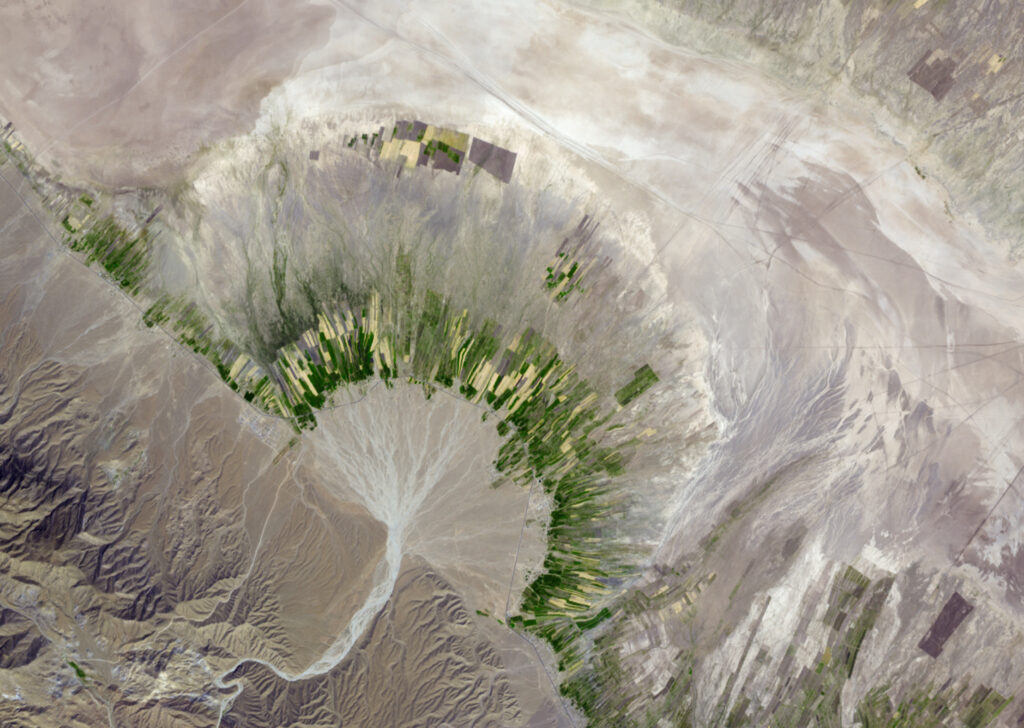
Qanats are traditionally built by a skilled labor force of muqannīs using hand labor. The occupation was passed down from father to son and historically paid well. The first step in qanat construction is to identify an appropriate water source. The search starts at the point where the alluvial fan meets the mountains, where water is more abundant, and the ground is easier to excavate. Muqannīs track the main water courses from the mountains or foothills to locate signs of subsurface water, such as deep-rooted vegetation or seasonal seeps. After a trial well is dug to determine the water table’s location, equipment is assembled for construction, including containers, ropes, reels, hatchets, and shovels, among others. Although the construction methods are straightforward, qanat construction requires a detailed understanding of subterranean geology and a degree of engineering sophistication.
The gradient of the qanat must be carefully controlled. The crew usually begins the construction from the destination where water will be delivered into the soil and works towards the source, the test well. Vertical shafts are excavated along the route, separated at a distance of 20–35 m, depending on the amount of work required to excavate them and the amount of effort required to excavate the space between them. In general, the shallower the qanat, the closer the vertical shafts. Most qanats in Iran run less than 5 km (3.1 mi), while some have been measured at approximately 70 km (43 mi) in length near Kerman. Deep, long qanats require years, even decades, to construct, and construction speed depends on the ground’s depth and nature.
The qanat’s water-carrying channel must have a sufficient downward slope that water flows easily. However, the downward gradient must not be so great as to create conditions under which the water transitions between supercritical and subcritical flow; if this occurs, the waves that result can lead to severe erosion that can damage or destroy the qanat. The slope’s choice is a trade-off between erosion and sedimentation, and precision is routinely obtained with a spirit level and string. In cases where the gradient is steeper, underground waterfalls may be constructed with appropriate design features, usually linings, to absorb the energy with minimal erosion.
Applications of qanats
Irrigation and drinking water supply
The primary applications of qanats are for irrigation, providing cattle with water, and drinking water supply. Other applications include cooling and ice storage.
Cooling
Further information: Evaporative cooler

Wind tower and qanat used for cooling
Qanats used in conjunction with a wind tower can provide cooling as well as a water supply. A wind tower is a chimney-like structure positioned above the house; of its four openings, the one opposite the wind direction is opened to move air out of the house. Incoming air is pulled from a qanat below the house. The air flow across the vertical shaft opening creates a lower pressure (see Bernoulli effect) and draws cool air up from the qanat tunnel, mixing with it. The air from the qanat is drawn into the tunnel at some distance away and is cooled both by contact with the cool tunnel walls/water and by the transfer of latent heat of evaporation as water evaporates into the air stream. In dry desert climates this can result in a greater than 15 °C reduction in the air temperature coming from the qanat; the mixed air still feels dry, so the basement is cool and only comfortably moist (not damp). Wind tower and qanat cooling have been used in desert climates for over 1000 years.[23]
A Persian Ab anbar with wind towers connected to a qanat
Ice storage
Further information: Yakhchāl
By 400 BCE, Persian engineers had mastered the technique of storing ice in the middle of summer in the desert.[24]
The ice could be brought in during the winters from nearby mountains, but in a more usual and sophisticated method they built a wall in the east–west direction near the yakhchal (ice pit). In winter, the qanat water would be channeled to the north side of the wall, whose shade made the water freeze more quickly, increasing the ice formed per winter day. Then the ice was stored in yakhchals—specially designed, naturally cooled refrigerators. A large underground space with thick insulated walls was connected to a qanat, and a system of windcatchers or wind towers was used to draw cool subterranean air up from the qanat to maintain temperatures inside the space at low levels, even during hot summer days. As a result, the ice melted slowly and was available year-round.[24]


Leave a Reply